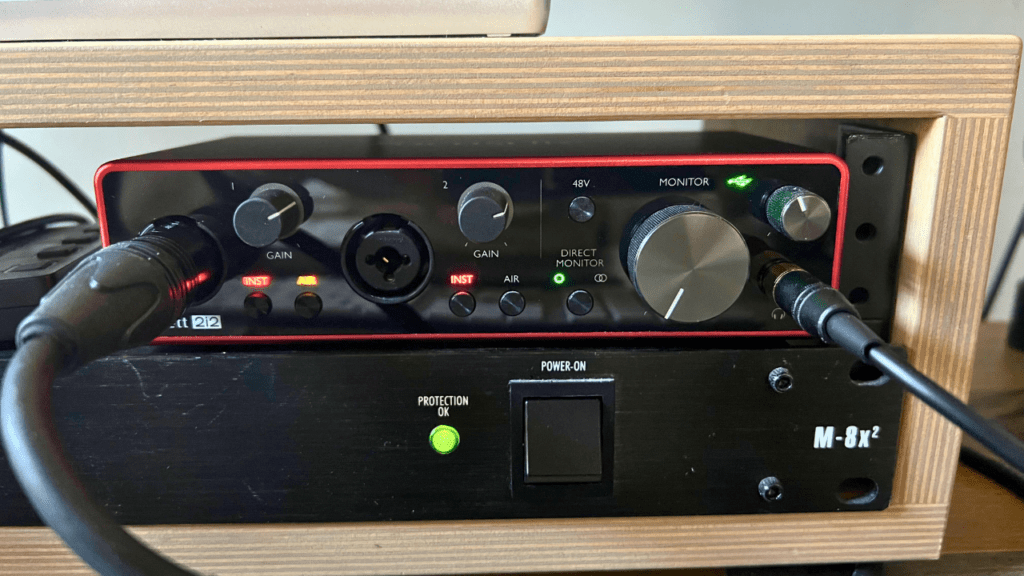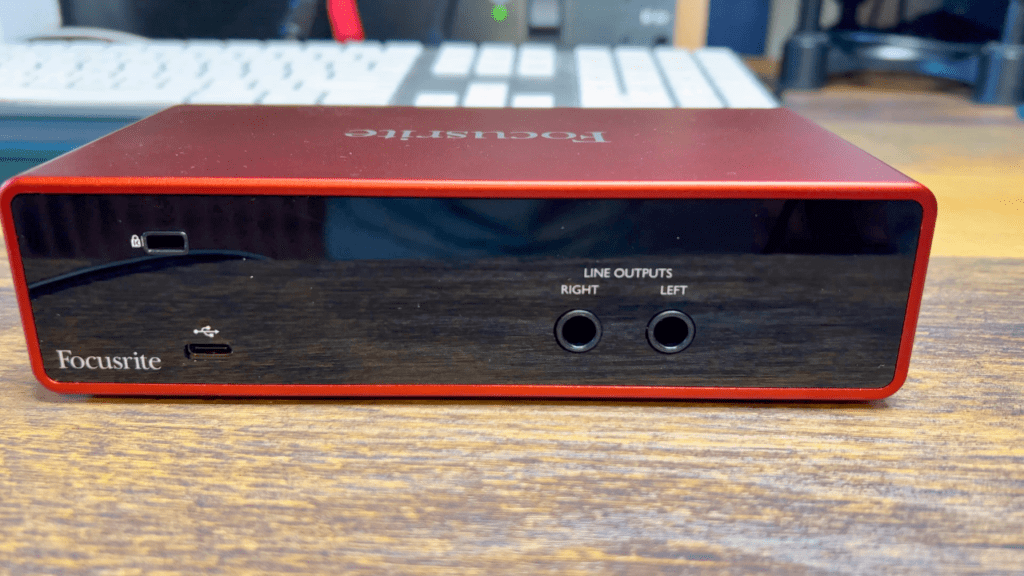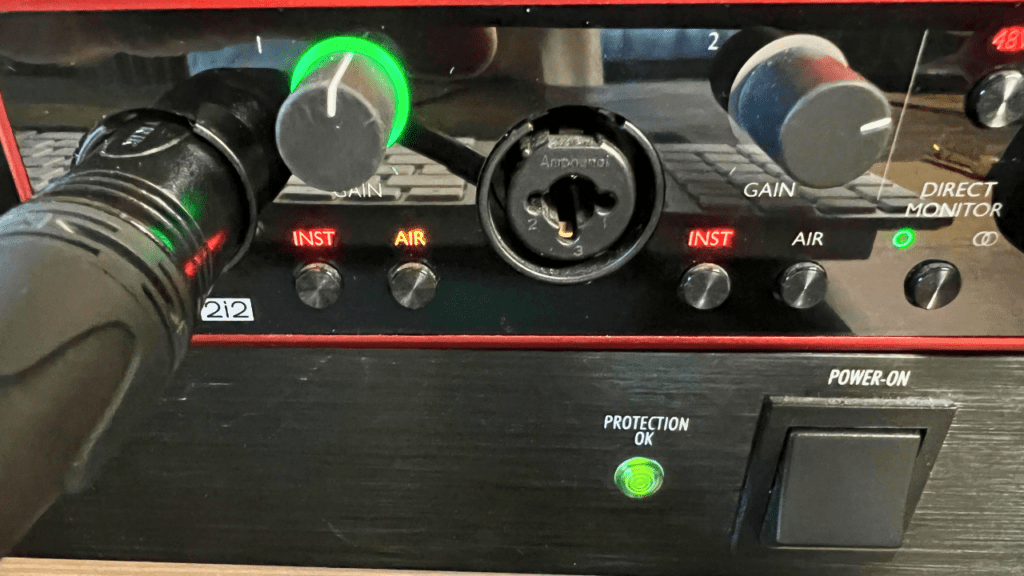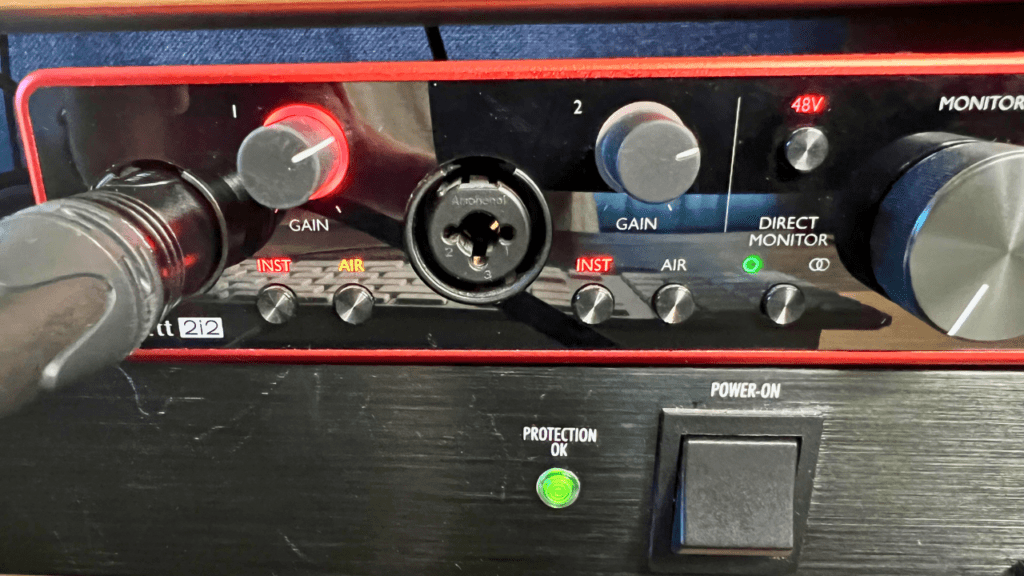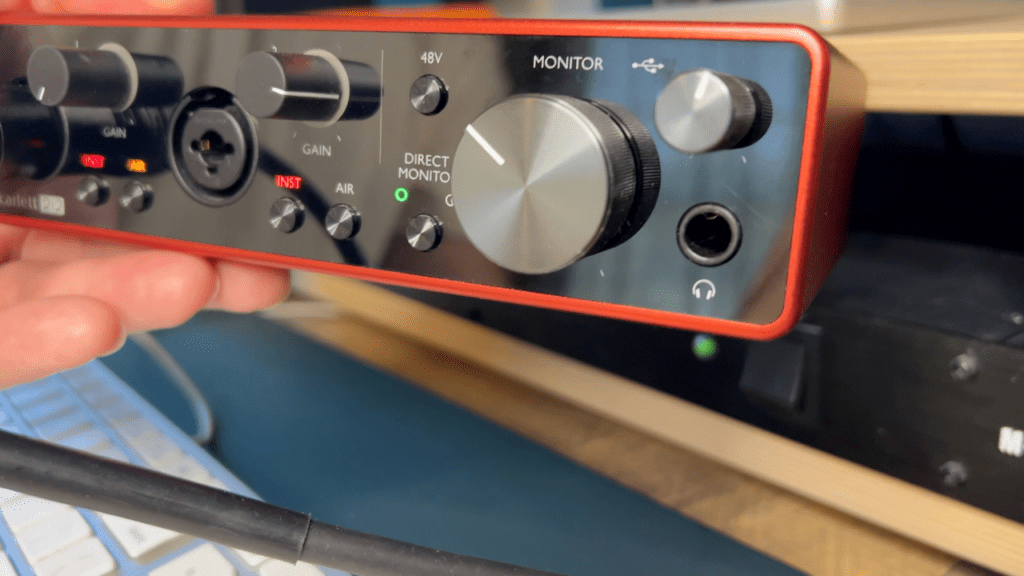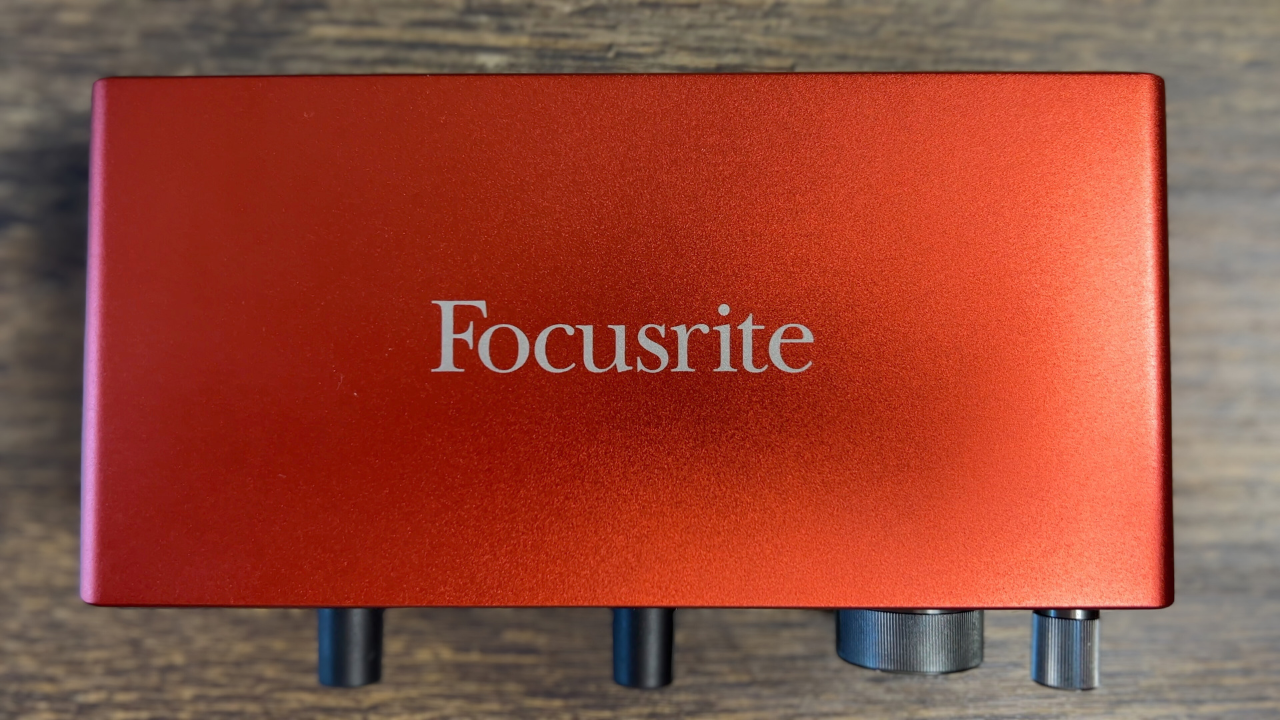
Whether starting a podcast for the first time or hoping to take your quality production to new heights, finding the best audio interface for podcasting is essential. The Focusrite Scarlett Series has emerged as a firm favorite with podcasters nationwide, and frankly, it’s not hard to see why.
In this quick guide, we’re breaking down everything you need to know about podcasting with Focusrite Scarlett audio interfaces.
We’ll answer all of your key questions, including but not limited to:
- What Focusrite Scarlett audio interface models are there?
- Who should choose the Focusrite Scarlett Series for podcasting?
- What are the benefits of using the Focusrite Scarlett podcasting interface?
- What are the limitations of the Focusrite Scarlett audio interfaces?
- Is the sound quality on par with other professional audio interfaces?
Ready to take your podcast audio to the next level? Of course, you are – we were ‘just testing.’ Here’s everything you need to know.
Just a heads up before we get into it. This post contains Amazon Affiliate links. As an Amazon Associate, we earn from qualifying purchases.
Onward.
What Is An Audio Interface?
If you’re new to creating podcasts, you must familiarize yourself with various equipment types.
An audio interface functions as a bridge, allowing XLR microphones to interface with a computer. It transforms the signals from the microphone into a digital format that the computer can recognize and process.
These devices come in a wide range of sizes and designs, featuring variable numbers of input and output ports to accommodate different types of equipment.
It’s the hub where you typically connect your headphones and studio speakers.
Ordinarily, an audio interface sits on your desk and is linked to your computer through a USB connection.
With a global audience of 464.7 million people having millions of podcast episodes at their fingertips, the demand for superior audio quality has never been greater.
Suppose your podcast fails to deliver top-tier production quality. In that case, listeners won’t hesitate to shift their attention to another show from the sea of options available.
In this competitive landscape, harnessing the power of an exceptional audio interface for your recording needs is not just an option. It’s a prerequisite for success. Ensuring pristine audio quality is instrumental in captivating listeners’ attention and setting your podcast apart in an increasingly crowded market.
The Focusrite Scarlett Series
As hardware manufacturers look to capitalize on an industry still growing with a 21.15% CAGR, the USB audio interface marketplace has become flooded with many solutions.
While not all podcasting audio interfaces are up to the task, the Focusrite Scarlett models are perfect for podcast creators of all experience levels.
The Focusrite Scarlett Series includes several models.
- Scarlett Solo – featuring one microphone input
- Scarlett 2i2 – featuring two microphone inputs
- Scarlett 18i8 – featuring four microphone inputs
All models connect laptops and relevant devices via USB.
We believe you should always buy an audio interface with 1-2 more inputs than you think you’ll need. You never know; your podcast might expand as you grow it.
Choosing The Right Scarlett
The Focusrite Scarlett audio interfaces all produce excellent sound quality and have been regarded as best in class.
It’s the go-to choice for over four million content creators, including an expanding segment of podcasters from novices to professionals across diverse genres.
When evaluating the different models, consider posing the following questions:
- What is my budget? – Fortunately, the Scarlett Series is affordable regarding audio equipment!
- Do I plan to record a solo podcast, have a local co-host, or have multiple co-hosts/guests?
- Am I planning to record podcasts on location, and will I need a light, compact device?
While there are some differences in specs, all of the Scarlett Series audio interfaces can produce world-class podcast recordings.
So, the main deciding factor between models for most users will relate to how many local hosts or interviewers you plan to have on your show.
Focusrite Scarlett 2i2 Specifications
Each model has its specifications, which can be researched in detail before purchase.
Though, here are some of the key specs from the 2i2. A staple piece of equipment at The Podcast Haven.
- Mic Input Frequency Response: 20Hz – 20kHz ± 0.1dB
- Mic Input Dynamic Range: 111dB (A-weighted)
- Mic Input Max Level: 9dBu (at minimum gain)
- Headphone Output Dynamic Range: 104dB (A-weighted)
- Headphone Maximum Output Level: 7dBu
It should also be noted that the latest generation features the best-performing mic preamps, the ability to record and mix at up to 24-bit/192kHz, and clean audio playback thanks to hum-free balanced outputs.
Why Focusrite?
Focusrite has been an industry titan for decades, renowned for its commitment to crafting high-quality audio interfaces and equipment.
The company’s relentless drive for sonic excellence, combined with cutting-edge technology, has positioned them as a staple in audio production, from home studios to professional recording setups.
Tracing its roots back to 1985, Focusrite was founded by Rupert Neve, one of the most respected names in audio equipment design. Over the years, the company has consistently set industry standards, transforming from a boutique operation to a global powerhouse in audio technology.
Moreover, Focusrite made a savvy strategic move by immersing itself in the burgeoning podcast industry over the past half-decade. This strategic maneuver has undeniably propelled them to market dominance.
So, the question isn’t, why Focusrite? It’s, why not Focusrite?
Here are five reasons why you will love a Focusrite Scarlett Audio Interface:
Easy Installation
Installing a Scarlett audio interface is generally a straightforward and user-friendly process.
Here’s a general outline:
- Unpack and Connect: Unpack your Scarlett interface and connect it to your computer using the supplied USB cable.
- Install Focusrite Control: Next, download and install the Focusrite Control software from the official Focusrite website. Focusrite Control is where you’ll dial in all your audio settings.
- Drivers Installation: The necessary drivers for your Scarlett interface will also be installed during the installation. These drivers enable your computer to communicate with the audio interface.
- Register Your Product: Registering your product on the Focusrite website is a good idea. This way, you can access technical support and stay updated on the latest news and software updates.
- Set Up Your Audio Software (DAW): Set up your Digital Audio Workstation (DAW) to interface with your Scarlett. This involves adjusting the audio settings in the software to use the Scarlett interface as the input and output device.
It’s important to note that exact steps can vary slightly depending on the specific model of the Scarlett interface and the type of computer (PC/Mac) you’re using.
Local and Remote Recording Capabilities
The Focusrite Scarlett audio interfaces empower you to capture studio-grade recordings locally and integrate seamlessly with remote recording applications.
This compatibility lets you capture high-definition audio during remote podcasts or video conversations.
In the wake of the pandemic, this method of recording podcasts has gained significant traction, predominantly due to its ability to transcend geographical limitations.
Therefore, the Focusrite Scarlett is a top-notch choice whether your recording is in-person or remote.
Sound Control
The Focusrite Scarlett audio interfaces offer robust and precise sound controls that allow users to fine-tune their audio to their specific needs.
With its high-quality preamps, you can adjust input gain to capture the cleanest sound from your microphone or instrument.
Speaking of preamps, there are colored halos around the gain knobs. These unique gain halos change color to notify you of your levels. These things are rad!
When the halo is green, your levels are good; if it turns red, the signal is clipping, and the gain should be reduced.
But green and red are the stock color settings that Scarlett’s come with.
You can customize the gain halos with up to seven colors!
The interfaces also feature direct monitoring. Direct monitor control is a notable feature of these interfaces, offering zero-latency monitoring throughout your recording sessions.
Indeed, encountering a delay when recording a podcast can be immensely disruptive! So, the immediacy that you hear exactly what is being recorded in real-time, making for a smoother, more seamless podcasting experience.
With zero-latency monitoring, you can avoid the disconcerting experience of audio lag, ensuring your recording sessions run flawlessly and efficiently.
Lastly, the included ‘Focusrite Control’ software gives users more granular control over routing and monitor mixes. This comprehensive set of sound controls contributes to the Scarlett’s reputation for delivering exceptional audio quality.
Portability
When setting up a podcast recording, whether at home or on the move, these interfaces’ lightweight, compact nature proves to be a huge advantage.
They offer unparalleled flexibility, allowing you to record high-quality audio anywhere.
Take the 2i2 model, for instance, it weighs just slightly over a pound, and its compact dimensions of 175mm x 47.5mm x 98.8mm make it highly portable.
The 18i8, though marginally larger and heavier, still maintains impressive portability.
Affordability
Budget considerations are key, particularly for those venturing into the podcasting world. Here, Focusrite interfaces truly shine by delivering outstanding quality without breaking the bank.
For example, on Amazon, you can find the 2i2 priced around $189, and the Solo model is even more budget-friendly at $129.
These competitive prices underscore Focusrite’s commitment to offering excellent value for money.
For Podcasters
The Focusrite Scarlett series of audio interfaces are designed for podcasters at every stage—whether you’re looking to elevate the quality of your existing content or striving for excellence right from the start.
They especially benefit those seeking superior sound control and output, even without extensive technical expertise.
The Upsides
- The entire range offers significant value for money
- It’s a top-notch choice for on-location recordings
- It provides flexibility for future microphone upgrades
- Compatibility extends to USB-enabled tablets
- Supports a broad array of software solutions
Final Thoughts
Stepping into podcasting or taking your content to a higher tier requires a reliable audio interface. The Focusrite Scarlett series stands as the ideal solution, offering significant control without being overly complex.
It’s an excellent investment for immediate and long-term podcasting objectives, making your podcasting journey both satisfying and professional.
Follow The Podcast Haven On Social Media
Listen To Clipped – A Podcast Haven Original
Check Out These Other Blog Posts
- Samson Q2U Podcast Microphone Features and Review
- Veed: How To Edit Video Podcast Clips In Minutes
- The Complete Guide To Recording a Podcast with Riverside.fm
- Unlock SEO and Discoverability With Podcast Show Notes
- Descript: A Podcast Editing Tool That Functions Like A Word Document
- How To Find Sponsors and Monetize Your Podcast

